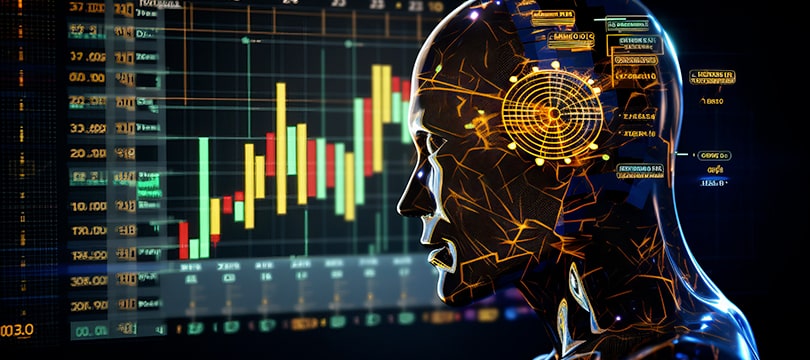AI and Forex: How Algorithms Are Transforming Currency Trading
March 18, 2024

The Forex Market represents one of the largest and most dynamic financial ecosystems in the world, where currencies from different nations are exchanged daily. Its economic relevance is undeniable. In fact, it serves as a barometer for global financial health and directly influences international trade, investments, and economic policy.
In this complex and constantly evolving scenario, artificial intelligence is emerging as a transformative force, promising to revolutionize the way investments are managed and trading decisions are made.
AI, with its ability to process and analyze enormous volumes of data at speeds and with precision previously unimaginable, offers unprecedented opportunities for Forex traders. This advanced technology is opening new horizons in many areas, and Forex is no exception. We discuss it here, providing an overview of practical applications, presenting the pros and cons of an increasingly massive integration of artificial intelligence in Forex.
Artificial Intelligence and Forex: An Overview
Artificial intelligence, in the context of Forex, refers to the use of advanced computational systems that are capable of learning autonomously from market information and adapting their trading strategies in real-time.
This self-learning ability distinguishes AI from traditional automated trading platforms, which operate following predefined static algorithms. Machine learning and deep learning technologies, two pillars of AI, allow models to analyze vast and complex historical data, identifying patterns and correlations that would escape manual analysis.
In Forex, this means being able to predict future currency movements with greater precision, based on a wealth of historical data and economic indicators that no trader could realistically process in real-time.
Artificial Intelligence and Forex: Key Technologies
The applications of artificial intelligence in Forex depend on two key technologies: machine learning and deep learning.
Machine learning utilizes algorithms that learn from data and improve their performance over time without being explicitly programmed for each specific task. This translates into trading systems that adapt their strategies based on acquired experience, enhancing the ability to react to new data or market changes.
Deep learning, a sub-branch of machine learning, employs advanced neural networks to analyze data in ways that simulate human intelligence, allowing for even more sophisticated analysis of market patterns.
These technologies not only increase the efficiency and precision of trading operations but also open the door to new strategies that would be too complex or sophisticated to be identified and exploited through traditional methods.
Together, machine learning and deep learning are redefining the field of Forex trading, offering powerful tools to navigate increasingly complex and interconnected markets. Technological progress in this regard allows not only for increased potential profits but also for the democratization of trading, making it accessible to a wider audience by lowering entry barriers, at least in terms of skills.
The Benefits of AI for Forex
The adoption of artificial intelligence in Forex brings numerous advantages, ranging from increased operational efficiency to reduced risk associated with impulsive or less informed trading decisions.
One of the main benefits is AI's ability to process and analyze data in real-time, allowing traders to quickly react to market changes that might escape human analysis.
This in-depth and high-speed analysis translates into more accurate predictions of market movements, potentially increasing investment returns. Furthermore, AI eliminates many human errors caused by psychological biases or a simple lack of attention, thus enabling a more objective and systematic approach to trading.
Another significant advantage is the automation of trading, which allows AI-based systems to operate 24 hours a day, 7 days a week, without the need for constant user supervision. This not only improves trading opportunities, taking advantage of favorable market conditions at any time, but also reduces the workload and stress for traders, who can set parameters and let the system manage operations.
Challenges and Limitations
Despite the numerous advantages, the use of AI in Forex presents challenges and limitations.
One of the main concerns regards data security and privacy. These concerns are justified by the fact that AI systems require access to vast volumes of sensitive information to function effectively.
Furthermore, there is a risk of over-optimization: an AI-based trading model might perform exceptionally well with historical data but fail to predict future market movements due to excessive focus on the past.
Another significant challenge is the complexity of interpreting results. Although AI can identify patterns and trends in market data, trading decisions often require contextual understanding and an assessment of economic implications that go beyond purely numerical analysis.
This means that human presence remains fundamental for interpreting and acting on the suggestions provided by AI systems, especially in unusual market situations or during unforeseen geopolitical events.




